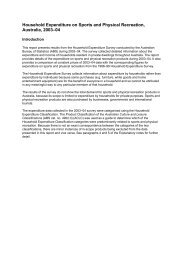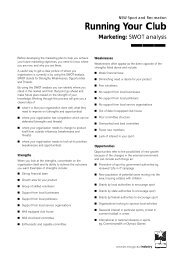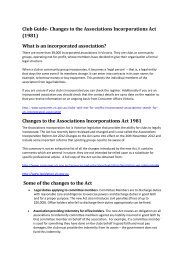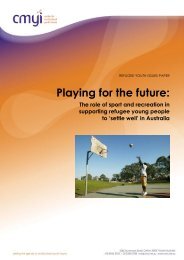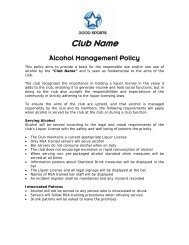School Playing Fields: Planning and Design Guidance - VicSport
School Playing Fields: Planning and Design Guidance - VicSport
School Playing Fields: Planning and Design Guidance - VicSport
You also want an ePaper? Increase the reach of your titles
YUMPU automatically turns print PDFs into web optimized ePapers that Google loves.
In some locations, playing fields might requirerobust boundary fencing to ensure the safety <strong>and</strong>security of users or the protection of facilities.For safe play, pitch layouts should includeadequate run-off margins around the playingareas, especially between adjacent pitches.Where pitches are to be located adjacent toroads, buildings or adjacent property, largerclearances may be required.For safety reasons, <strong>and</strong> to minimise any possibledamage to pitches, the position <strong>and</strong> orientationof shot, discuss, javelin <strong>and</strong> hammer throwingareas must be carefully chosen.If any facility is to be floodlit, care needs to betaken to ensure that light spill does not causea hazard or inconvenience to neighbouringproperties. Issues such as noise, access <strong>and</strong>parking should also be considered in relation toany sensitive neighbouring properties, particularlyif intensive community use is envisaged. Earlydiscussion with the local planning authority mayassist in identifying the most appropriate locationfor all-weather <strong>and</strong> floodlit facilities within the site.Other activities<strong>School</strong> playing fields also have the potential tooffer other activities to those pupils who do notengage well with the traditional pitch sports. Anarea for cycle skills development should beprovided, perhaps utilising those areas unsuitablefor use as sports pitches. <strong>School</strong> grounds canalso provide an excellent area for introductoryorienteering <strong>and</strong> provision of a permanent markercourse should be considered as teachers havelimited time to set courses before lessons.Primary schools<strong>Playing</strong> field requirements in primary schoolshave changed a great deal in the past 20 to 30years. A decline in the number of male primaryschool teachers meant a correspondingreduction in the level of primary school football,<strong>and</strong> curricular <strong>and</strong> other pressures have meant adecrease in other sports programmes. Morerecently, increased emphasis on healthy lifestyleshas led to the introduction of a number ofnational <strong>and</strong> local measures intended toencourage primary school children to be moreactive. The growth in small-sided versions ofpitch sports has significant implications for pitchrequirements. Unfortunately, in many primaryschools, the level <strong>and</strong> quality of provision for PE<strong>and</strong> sport has been poor <strong>and</strong> it has been difficultfor schools to properly adopt <strong>and</strong> implementvarious national <strong>and</strong> local initiatives as a result.To meet both curricular <strong>and</strong> extra-curricular needs,a primary school site should have access to:• hard surface areas for play, informal socialpurposes, assembly <strong>and</strong> physical education<strong>and</strong> sport;• informal social areas;• l<strong>and</strong>scape <strong>and</strong> habitat areas; <strong>and</strong>• playing fields.<strong>Playing</strong> fields for primary schools are muchsmaller than those of secondary schools <strong>and</strong> arenormally based on multi-purpose facilities. Muchof both curricular <strong>and</strong> extra-curricular activity willbe informal. Formal games will, for the most part,be small-sided or ‘mini’ versions of the sportsplayed at secondary schools.sportscotl<strong>and</strong>’s recommended unit of provisionis a small multi-purpose SGP. A pitch of around60m x 40m (plus safety margins of 2m on allsides) will be suitable for PE, small-sided sports<strong>and</strong> informal activity. If only grass playing fieldsare provided, a similarly sized pitch will berequired for each stream at a school, with safetymargins increased to 3m <strong>and</strong> the provision of a6m wide lateral strip to allow the pitch to bemoved to reduce wear <strong>and</strong> tear. Any such grasspitches must be well-constructed <strong>and</strong> wellmaintainedto accommodate the required levelsof use – at present, most primary school grasspitches do not meet this quality threshold.As with secondary schools, the <strong>School</strong> PremisesRegulations apply. Local authorities should ensurethat their playing field provision is compliant.Model pitch layoutsThe following drawings (overleaf) illustrateoptimum layouts for a range of playing fieldsizes. They assume a level, regularly shapedsite is available – although in reality this is notalways the case. <strong>Design</strong>ers may therefore haveto adapt layouts accordingly but should stillapply the same principles in respect of pitchorientation, positioning of synthetic surfaces<strong>and</strong> provision for summer games. One or moresynthetic pitches should be added to theselayouts as required, ideally positioned closeto the PE <strong>and</strong> changing block.For detailed advice on pitch markings referto sportscotl<strong>and</strong>’s Pitch <strong>and</strong> Court MarkingsTechnical Digest. This was updated in 2006<strong>and</strong> can be downloaded free of charge fromwww.sportscotl<strong>and</strong>.org.uk<strong>School</strong> <strong>Playing</strong> <strong>Fields</strong> 36<strong>School</strong> <strong>Playing</strong> <strong>Fields</strong> 37



